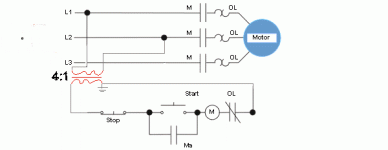Eric Nelson
Lifetime Supporting Member + Moderator
Sorry Ron, I have to agree with 93 on all 3 points he mentioned. I disagee with the "I would have 2 seperate transformers" statement though. Most of the panels I build operate on 480 or 240V (or 208V) single/three phase, and I have NEVER added a 1:1 transformer for the 480 or 240V loads. Sure there's a transformer for the 120V stuff, with one leg grounded. I use this to power the PLC, 24VDC power supply, and whatever else happens to need 120V. If my line voltage was 480V and I needed 240V in addition to my 120V, I'd use a 480 to 120/240V center-tapped transformer and ground the center tap. I can't think of an instance where I have ever (purposely) grounded one leg of a 240V secondary off a single-phase transformer.
I think Vic has provided the best reasoning why the PICO is rated for 240V use. Notice that L2 is also the 'common' for the AC inputs. Looks like they were just trying to save on the number of terminals needed. Notice the lack of a gounding terminal as well...
Since I always use 120V to power my PLCs, I wouldn't run into this 'L2 must be grounded problem', but I've seen plenty of (US built) equipment where the PLC was powered by the 240V (ungrounded) supply. Many panel designers might skip adding a transformer if it's only purpose was to provide 120V for a PLC that can operate on 240V.
Then again, the PICO is not a PLC!...
beerchug
-Eric
I think Vic has provided the best reasoning why the PICO is rated for 240V use. Notice that L2 is also the 'common' for the AC inputs. Looks like they were just trying to save on the number of terminals needed. Notice the lack of a gounding terminal as well...
Since I always use 120V to power my PLCs, I wouldn't run into this 'L2 must be grounded problem', but I've seen plenty of (US built) equipment where the PLC was powered by the 240V (ungrounded) supply. Many panel designers might skip adding a transformer if it's only purpose was to provide 120V for a PLC that can operate on 240V.
Then again, the PICO is not a PLC!...
beerchug
-Eric




